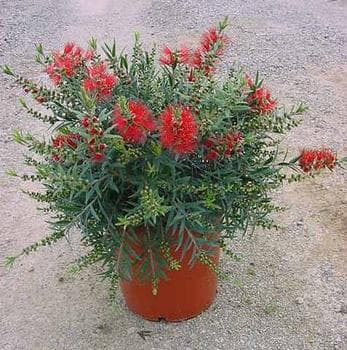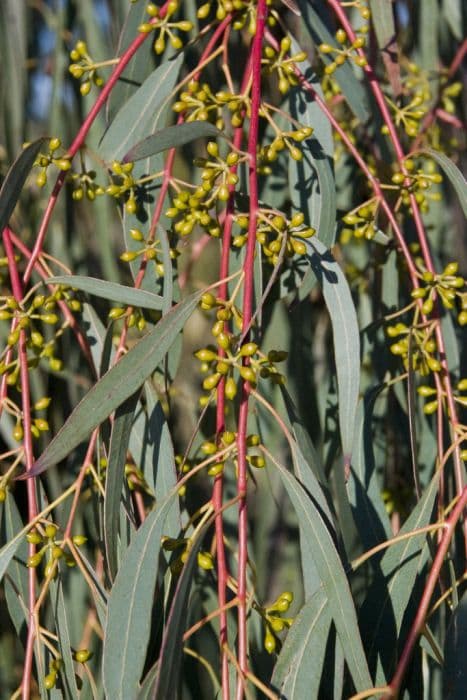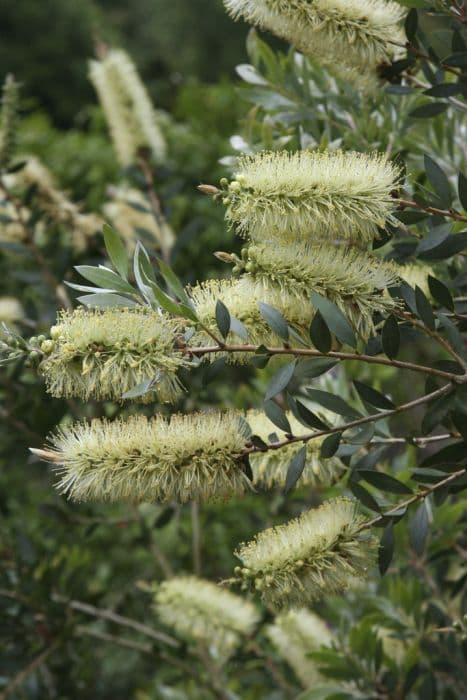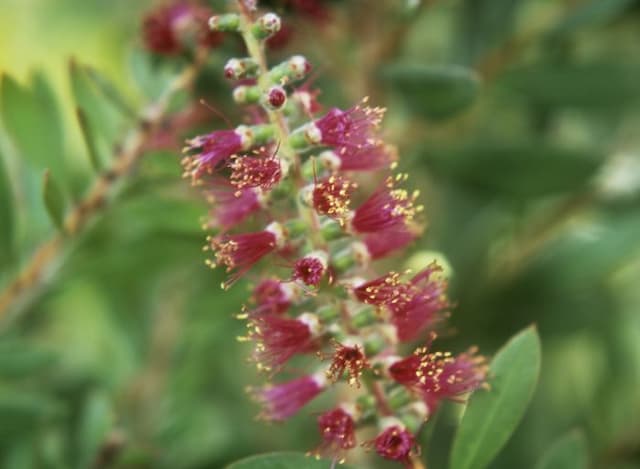New Zealand Myrtle Lophomyrtus × ralphii 'Little Star' (v)

ABOUT
Little Star is a decorative evergreen shrub known for its eye-catching foliage. The leaves are small and boast a medley of colors, ranging from green to variegated hues of cream, pink, and reddish tones, which can change with the seasons or as the leaves mature. The leaf edges are often attractively tinged with a pinkish or reddish color, especially in the newer growth, providing a colorful contrast against the darker older leaves. This plant produces small, star-shaped flowers that are typically white or pale pink, adding to its decorative appearance. Following the flowers, the Little Star may bear berries that can be red, purple, or almost black, providing yet another point of visual interest. The intricate interplay of the multicolored leaves makes this shrub a standout in any garden setting. Its dense, bushy habit and the glossy texture of the leaves give it a lush and vibrant look that can complement various garden designs and landscapes.
About this plant
 Names
NamesFamily
Myrtaceae
Synonyms
New Zealand Myrtle, Lophomyrtus 'Little Star', Ralph's Lophomyrtus
Common names
Lophomyrtus × ralphii 'Little Star' (v).
 Toxicity
ToxicityTo humans
Lophomyrtus × ralphii 'Little Star', or more commonly known as Lophomyrtus, does not have a well-documented profile concerning its toxicity to humans. There is limited information available on its potential poisonous effects if ingested. As a precautionary measure, it is recommended to avoid consuming any part of the plant. If suspicion of poisoning from the plant occurs, medical advice should be sought immediately.
To pets
Lophomyrtus × ralphii 'Little Star', commonly referred to as Lophomyrtus, is not widely recognized for its toxicity to pets. There is a lack of specific information regarding the plant's poisonous properties to animals. It is advisable to prevent pets from ingesting any part of the plant, and pet owners should monitor their pets for any signs of illness if they consume Lophomyrtus. If symptoms of poisoning appear, consultation with a veterinarian should be made promptly.
 Characteristics
CharacteristicsLife cycle
Perennials
Foliage type
Evergreen
Color of leaves
Variegated
Height
3-5 feet (0.9-1.5 meters)
Spread
3-5 feet (0.9-1.5 meters)
Plant type
Shrub
Hardiness zones
8-11
Native area
New Zealand
Benefits
 General Benefits
General Benefits- Ornamental appeal - The variegated foliage of 'Little Star' adds aesthetic value and visual interest to gardens and landscapes.
- Compact size - Its small stature makes it suitable for growing in containers, small gardens, or as a border plant.
- Low maintenance - The plant is relatively easy to care for, requiring minimal upkeep beyond regular watering and occasional pruning.
- Hardiness - It can cope with a range of temperatures and is frost-tolerant, making it suitable for a variety of climates.
- Versatility - Lophomyrtus 'Little Star' can be used for a range of garden designs, from formal hedges to informal mixed beds.
- Wildlife support - Its flowers and berries can attract birds and beneficial insects to the garden.
- Evergreen foliage - It retains its leaves year-round, providing constant greenery and structure in the garden.
 Medical Properties
Medical PropertiesThis plant is not used for medical purposes.
 Air-purifying Qualities
Air-purifying QualitiesThis plant is not specifically known for air purifying qualities.
 Other Uses
Other Uses- Lophomyrtus × ralphii 'Little Star', commonly known as New Zealand Myrtle, can be used as a natural dye source; the leaves and berries may provide subtle colors for fabrics.
- In landscape design, New Zealand Myrtle 'Little Star' can be used for topiary as its dense growth habit allows for shaping into various forms.
- The plant's wood is sometimes utilized in crafting small decorative items like picture frames or jewelry boxes due to its fine grain and potential for a polished finish.
- New Zealand Myrtle can be included in educational programs or botanical gardens for studying hybridization and genetic variation in plants.
- The dense and intricate foliage of New Zealand Myrtle can provide an excellent backdrop for photographers or painters who are capturing the beauty of garden scenes.
- Gardeners may use the trimmed branches and foliage as mulch to suppress weeds and retain soil moisture around other plants.
- As a bonsai, the New Zealand Myrtle offers enthusiasts a unique option for creating miniature landscapes due to its small leaves and attractive berries.
- The contrasting colors of leaves and berries can be used in floral arrangements or as part of decorative wreaths during festive seasons.
- In wildlife gardens, New Zealand Myrtle can attract birds that feed on the berries, supporting local biodiversity.
- The plant may be used in sensory gardens where the focus is on texture and color, providing touchable foliage and visually striking variegation.
Interesting Facts
 Feng Shui
Feng ShuiThe plant named Lophomyrtus × ralphii 'Little Star' is not used in Feng Shui practice.
 Zodiac Sign Compitability
Zodiac Sign CompitabilityLophomyrtus × ralphii 'Little Star' is not used in astrology practice.
 Plant Symbolism
Plant Symbolism- New Beginnings: The name 'Little Star' implies a sense of starting fresh or embarking on a new journey or endeavor, with the young star being a metaphor for new opportunities.
- Resilience and Adaptability: Lophomyrtus × ralphii 'Little Star' is known for its hardiness and its ability to adapt to various environments, symbolizing the resilience and flexibility required to thrive in different conditions.
- Diversity: With its variegated foliage, 'Little Star' celebrates diversity, representing the beauty of various qualities and characteristics coming together to create something unique.
- Growth: As a plant, 'Little Star' naturally symbolizes growth and development, both physically and metaphorically, as in personal growth or the expansion of an idea or project.
 Water
WaterThe New Zealand myrtle 'Little Star' prefers consistently moist soil, but be careful not to overwater. To maintain the right moisture level, water the plant when the top inch of soil feels dry to the touch. Generally, this will be about once a week, depending on the environmental conditions and the size of the plant and pot. A good approach is to offer the plant about 16 to 24 ounces of water each watering session for a medium-sized pot, allowing the water to drain freely out of the bottom. Always ensure that the pot has good drainage to prevent waterlogging, which can lead to root rot.
 Light
LightNew Zealand myrtle 'Little Star' thrives in bright, indirect light conditions. It is best positioned in a spot where it can receive plenty of light without being exposed to the harsh midday sun. A north-facing window or an eastern exposure where it can get gentle morning sunlight would be ideal. However, if placed in too much direct sunlight, the leaves may scorch, while too little light can lead to leggy growth and fewer leaves.
 Temperature
TemperatureNew Zealand myrtle 'Little Star' enjoys temperatures between 50°F and 75°F, making it suitable for most indoor environments. Avoid exposing the plant to temperatures below 40°F, as cold drafts or frost can severely damage it. Ideally, maintain a consistent temperature, avoiding fluctuations and keeping the plant away from heating vents and air conditioners to prevent stress.
 Pruning
PruningPrune New Zealand myrtle 'Little Star' to maintain its shape and encourage fuller growth. The best time to prune is in the spring before the new growth starts. Lightly trim the plant to remove any dead or damaged branches and to keep the plant looking tidy. Pruning every year or every other year will typically suffice to keep the plant healthy and well-shaped.
 Cleaning
CleaningAs needed
 Soil
SoilNew Zealand Myrtle 'Little Star' prefers well-draining soil with a mix of potting soil, peat, and perlite. The ideal soil pH should be slightly acidic to neutral, around pH 5.5 to 7.
 Repotting
RepottingNew Zealand Myrtle 'Little Star' should be repotted every 2 to 3 years or when it outgrows its current pot to allow for continued growth and root health.
 Humidity & Misting
Humidity & MistingNew Zealand Myrtle 'Little Star' thrives in moderate to high humidity levels; aim for a humidity range of around 40-60%.
 Suitable locations
Suitable locationsIndoor
Place in bright, indirect light and keep soil moist.
Outdoor
Plant in partial shade, protect from strong winds.
Hardiness zone
9-11 USDA
 Life cycle
Life cycleThe life cycle of Lophomyrtus × ralphii 'Little Star' begins with seed germination, where the embryo within the seed grows into a small seedling when given appropriate warmth, moisture, and soil conditions. The seedling stage involves the development of roots and shoots, allowing the plant to photosynthesize and grow stronger. As the plant enters the juvenile phase, it develops a robust root system and foliage, and continues to grow in height and width. In the mature stage, Lophomyrtus 'Little Star' may produce small, inconspicuous flowers followed by berries if it is a flowering variety and environmental conditions are favorable. After several seasons, as the plant ages, it may experience reduced growth and vigor, and begin to show signs of senescence. Eventually, the plant completes its life cycle by dying, where its organic matter decays and contributes to soil fertility, potentially aiding the growth of new Lophomyrtus 'Little Star' plants if seeds are present.
 Propogation
PropogationPropogation time
Spring-Early Summer
The New Zealand Myrtle 'Little Star' can be propagated through semi-hardwood cuttings, a method commonly employed due to its ease and effectiveness. Semi-hardwood cuttings are taken during the later part of summer, when the new growth has begun to mature and harden slightly. Cuttings should be around 4 to 6 inches (10 to 15 cm) in length, with the lower leaves removed to expose a clean stem which can be inserted into a rooting medium. The base of the cutting can be dipped in rooting hormone to encourage root development. The cutting should then be placed in a well-draining potting mix, kept moist, and placed in a warm, sheltered location with indirect sunlight. A plastic cover can be used to maintain humidity around the cutting, promoting root growth. After a few weeks, when the cuttings have rooted sufficiently, they can be potted up into individual containers.









